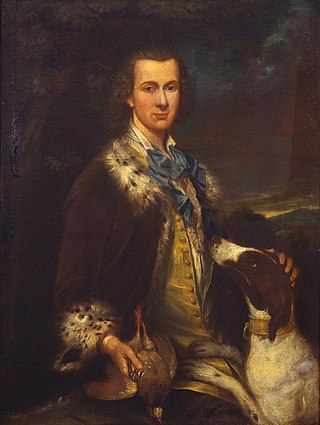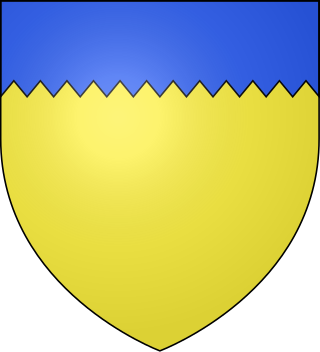
Duke of Leinster is a title in the Peerage of Ireland and the premier dukedom in that peerage. The subsidiary titles of the Duke of Leinster are: Marquess of Kildare (1761), Earl of Kildare (1316), Earl of Offaly (1761), Viscount Leinster, of Taplow in the County of Buckingham (1747), Baron of Offaly, Baron Offaly (1620) and Baron Kildare, of Kildare in the County of Kildare (1870). The viscounty of Leinster is in the Peerage of Great Britain, the barony of Kildare in the Peerage of the United Kingdom, and all other titles in the Peerage of Ireland. The courtesy title of the eldest son and heir of the Duke of Leinster is Marquess of Kildare. The Duke of Leinster is the head of the House of Kildare.

Marquess of Rockingham, in the County of Northampton, was a title in the Peerage of Great Britain. It was created in 1746 for Thomas Watson-Wentworth, 1st Earl of Malton. The Watson family descended from Lewis Watson, Member of Parliament for Lincoln. He was created a Baronet, of Rockingham Castle in the County of Northampton, in the Baronetage of England in 1621. In 1645 he was further honoured when he was raised to the Peerage of England as Baron Rockingham. The third Baron served as Lord-Lieutenant of Kent. In 1714 he was created Baron Throwley, Viscount Sondes and Earl of Rockingham in the Peerage of Great Britain. His eldest son Edward Watson, Viscount Sondes, predeceased him and he was succeeded by his grandson, the second Earl. The second Earl was Lord-Lieutenant of Kent before his early death in 1745. He was childless and was succeeded by his younger brother, Thomas. He had previously represented Canterbury in Parliament.
Baron Kerry is an ancient title in the Peerage of Ireland, named after County Kerry. It was created circa 1223 for Thomas FitzMaurice, Lord OConnello, son of Maurice FitzGerald, Lord of Llanstephan.

Earl of Limerick is a title that has been created twice in the Peerage of Ireland, associated first with the Dongan family, then with the Pery family. It should not be confused with the title Viscount of the City of Limerick held by the Hamilton family also Earls of Clanbrassil.

Earl Fitzwilliam was a title in both the Peerage of Ireland and the Peerage of Great Britain held by the head of the Fitzwilliam family.

Richard FitzWilliam, 5th Viscount FitzWilliam, PC (Ireland), of Mount Merrion in Dublin, was an Irish nobleman and Whig politician.
Earl of Tyrconnell is a title that has been created four times in the Peerage of Ireland.
Earl of Fingall and Baron Fingall were titles in the Peerage of Ireland. Baron Fingall was a title in the Peerage of the United Kingdom. The seat of the title-holders was, from its establishment until 1953, Killeen Castle in County Meath, Ireland, and there was an ongoing close relationship with the related Plunkett family of Dunsany, and with the Viscounts Gormanston, with whom they intermarried. Around 1426, Christopher Plunkett was created Baron Killeen: his seven sons founded five separate branches of the Plunket family, including the Plunkets of Dunsany, Rathmore and Dunsoghly. He also had a daughter Matilda, who became celebrated as "the bride of Malahide", when her first husband, Thomas Hussey, Baron Galtrim, was reputedly murdered on their wedding day.
Oliver FitzWilliam, 1st Earl of Tyrconnell and 2nd Viscount FitzWilliam, was an Irish nobleman.
Elizabeth FitzGerald was the first wife of Lucas Plunket, who succeeded as Baron Killeen in 1613, and who in due course became the 1st Earl of Fingall in 1628. They lived at Killeen Castle, County Meath in Ireland. She was a daughter of Henry FitzGerald, 12th Earl of Kildare, and therefore sister to Bridget, the Countess of Tyrconnell and wife of Prince Rory O'Donnell, 1st Earl of Tyrconnell.

Richard FitzWilliam, 7th Viscount FitzWilliam of Mount Merrion, Dublin, Ireland, and of FitzWilliam House in the parish of Richmond in Surrey, England, was an Anglo-Irish nobleman in the Peerage of Ireland who was a benefactor and musical antiquarian who founded the Fitzwilliam Museum in Cambridge, England, with a bequest of his library and art collection. He was also a significant urban developer in the City of Dublin. He served as a Member of Parliament for Wilton in Wiltshire, England, from 1790 until his death.

Butler is the name of a noble family whose members were, for several centuries, prominent in the administration of the Lordship of Ireland and the Kingdom of Ireland. They rose to their highest prominence as Dukes of Ormonde. The family has produced multiple titles such as Baron Cahir, Baron Dunboyne, Viscount Ikerrin, Viscount Galmoye, Viscount Mountgarret, Viscount Thurles, Earl of Carrick, Earl of Kilkenny, Earl of Ormond, Earl of Ossory, Marquess of Ormonde and Duke of Ormonde. Variant spellings of the name include le Boteler and le Botiller. The Butlers were descendants of Anglo-Norman lords who participated in the Norman invasion of Ireland in the 12th century. The surname has its origins in the hereditary office of "Butler (cup-bearer) of Ireland", originating with Theobald Walter, 1st Chief Butler of Ireland. The arms of later family members depicted three cups in recognition of their original office.

Richard FitzWilliam, 6th Viscount FitzWilliam, KB, PC, FRS, of Mount Merrion, near Dublin, Ireland, was an Anglo-Irish peer and property developer.

Merrion Castle was a castle situated about 300m south of the present-day Merrion Gates, to the south of Dublin city centre. Built in the early fourteenth century, it was from the sixteenth century to the early eighteenth century the principal seat of the Fitzwilliam family, who acquired the title Viscount Fitzwilliam. After the Fitzwiliams moved to Mount Merrion House in about 1710 the castle fell into ruin, and it was demolished in 1780, though there were remains visible as late as 1837. No trace of Merrion Castle survives today. It was located opposite Merrion Gates, on the site of St. Mary's Home and School for the Blind. Its location, and the modern site of St.Mary's, can be seen on historical maps, including the six-inch (1829-1841) Ordnance Survey of Ireland maps.
Thomas FitzWilliam, 1st Viscount Fitzwilliam (1581–1650) was an Irish nobleman of the Stuart age. He was born to wealth and privilege, and acquired a peerage, but due to his loyalty to the English Crown, he suffered considerable hardship during the English Civil War, and died in poverty.
William FitzWilliam, 3rd Viscount FitzWilliam (c.1610–1674) was an Irish nobleman of the Stuart era. He fought on the Royalist side during the English Civil War, but later made his peace with the Cromwellian regime. In his later years, he openly professed the Roman Catholic faith, which was then illegal.
Thomas FitzWilliam, 4th Viscount FitzWilliam (c.1640–1704) was an Irish nobleman and statesman; he was a leading Irish Jacobite, and a political figure of some importance during the Williamite War in Ireland.
James Fitzwilliam was an Irish landowner and judge who held the office of Chief Baron of the Irish Exchequer. He was the ancestor of the prominent Dublin landowning family which acquired the titles Viscount FitzWilliam and Earl of Tyrconnell.
Hercules Langford Rowley PC was an Irish politician and landowner.











